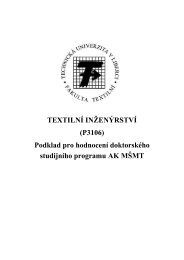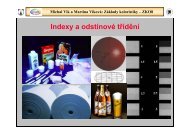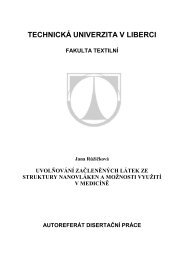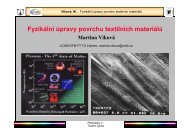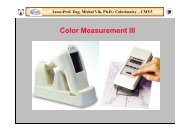Topics of Ph.D. thesis for students in doctoral study program 2013
Topics of Ph.D. thesis for students in doctoral study program 2013
Topics of Ph.D. thesis for students in doctoral study program 2013
Create successful ePaper yourself
Turn your PDF publications into a flip-book with our unique Google optimized e-Paper software.
Some special protective garments like anti-ballistic vests do not support the water and vapour transfer <strong>in</strong> thethickness direction. There<strong>for</strong>e, moisture must be evaporated from the edges <strong>of</strong> the used cloth<strong>in</strong>g pieces.Un<strong>for</strong>tunately, standard methods do not make possible to measure and <strong>in</strong>vestigate the <strong>in</strong>-plane moisturetransfer <strong>in</strong> fabrics. In the <strong>study</strong>, a new experimental method will be used, which enables the determ<strong>in</strong>ation <strong>of</strong>this unusual way <strong>of</strong> moisture transfer <strong>in</strong> textiles. Experimental results will be compared with the theoreticalones.Thema: Air transmission <strong>in</strong> the plane <strong>of</strong> protective garmentsSupervisors: pr<strong>of</strong>. Ing. Luboš Hes, DrSc. Dr. h. c.Supervisor specialist: doc. Ing Vladimír Bajzik, <strong>Ph</strong>.D. and Ing. Marie Havlová, <strong>Ph</strong>.D.Contact email <strong>for</strong> more <strong>in</strong><strong>for</strong>mation: lubos.hes@tul.cz, vladimir.bajzik@tul.cz, marie.havlova@tul.czSome special protective garments like anti-ballistic vests do not allow the air transfer <strong>in</strong> the thicknessdirection. There<strong>for</strong>e, air exchange must take place from the edges <strong>of</strong> the used fabrics. Un<strong>for</strong>tunately,standard methods do not provide the <strong>study</strong> <strong>of</strong> the <strong>in</strong>-plane air transmission <strong>in</strong> fabrics. In the <strong>study</strong>, a newexperimental method will be used, which enables the determ<strong>in</strong>ation air permeability <strong>of</strong> textiles <strong>in</strong> this unusualdirection. Experimental results will be compared with the theoretical ones.Thema: Thermal resistance <strong>of</strong> firemen cloth<strong>in</strong>g exposed to large radiation heat fluxSupervisors: pr<strong>of</strong>. Ing. Luboš Hes, DrSc. Dr. h. c.Supervisor specialist: doc. Ing Vladimír Bajzik, <strong>Ph</strong>.D.Contact email <strong>for</strong> more <strong>in</strong><strong>for</strong>mation: lubos.hes@tul.cz, vladimir.bajzik@tul.czFiremen cloth<strong>in</strong>g made <strong>of</strong> aramide and nomex fibres protects the wearer aga<strong>in</strong>st large radiation flux.Standard test methods <strong>for</strong> determ<strong>in</strong>ation <strong>of</strong> thermal resistance <strong>of</strong> such cloth<strong>in</strong>g cannot be employed, as most<strong>of</strong> the heat pass<strong>in</strong>g through the cloth<strong>in</strong>g dur<strong>in</strong>g their use <strong>in</strong> action is transferred by radiation. That is why newstandards <strong>of</strong> test<strong>in</strong>g <strong>of</strong> cloth<strong>in</strong>g under conditions simulat<strong>in</strong>g the real radiation flux were developed <strong>in</strong> the lastdecade. However, heat flux <strong>in</strong> these test<strong>in</strong>g systems is measured by means <strong>of</strong> dynamic thermal calorimeters,which exhibit certa<strong>in</strong> disadvantages. In the <strong>study</strong>, a novel method <strong>of</strong> determ<strong>in</strong>ation <strong>of</strong> thermal resistance <strong>of</strong>firemen cloth<strong>in</strong>g will be used, which is based on the use <strong>of</strong> vertical hotplate which enable steady state heatflux measurements by means <strong>of</strong> special high temperature resistant sensors.Thema: Cool<strong>in</strong>g efficiency <strong>of</strong> fabrics made <strong>of</strong> micro and nan<strong>of</strong>ibresSupervisors: pr<strong>of</strong>. Ing. Luboš Hes, DrSc. Dr. h. c.Supervisor specialist: Ing. Pavla Tes<strong>in</strong>ová, <strong>Ph</strong>.D.Contact email <strong>for</strong> more <strong>in</strong><strong>for</strong>mation: lubos.hes@tul.cz, pavla.tes<strong>in</strong>ova@tul.czFabrics with high cool<strong>in</strong>g flux <strong>in</strong> wet state may may contribute to thermal com<strong>for</strong>t <strong>of</strong> a weather <strong>in</strong> the hot-wetclimate. The cool<strong>in</strong>g flux <strong>in</strong>creases with the mass transfer surface <strong>of</strong> the studied fabrics, but also depends oncomposition and geometry <strong>of</strong> these special fabrics. In the <strong>study</strong>, the effect <strong>of</strong> the mentioned parameters <strong>of</strong>fabrics made <strong>of</strong> micro- and nan<strong>of</strong>ibres on their cool<strong>in</strong>g flow will be theoretically and experimentally analyzed.Thema: Air permeability <strong>of</strong> fabrics as the function <strong>of</strong> the air humidity and temperatureSupervisor: pr<strong>of</strong>. Ing. Luboš Hes, DrSc. Dr. h. c.Supervisor specialist: doc. Ing Vladimír Bajzik, <strong>Ph</strong>.D.Contact email <strong>for</strong> more <strong>in</strong><strong>for</strong>mation: lubos.hes@tul.cz, vladimir.bajzik@tul.czIn last decades, many studies were published, <strong>in</strong> which the effect <strong>of</strong> the air humidity and temperature on thefabrics air permeability was theoretically and experimentally analyzed. However, most <strong>of</strong> the studies refers tothe fabric permeability at the standard laboratory conditions, but <strong>in</strong> the real life, fabrics are also used atdiferent climatic conditions. The purpose <strong>of</strong> the <strong>study</strong> is to <strong>in</strong>vestigate theoretically and experimentally the airpermeability (air flow) <strong>of</strong> selected textile fabrics (differ<strong>in</strong>g <strong>in</strong> structure and composition) at large extension <strong>of</strong>the air humidity and temperature. New experimental setup <strong>for</strong> this <strong>study</strong> is available.Theme: Thermal Behavior <strong>of</strong> Aerogel Based MaterialsSupervisor: pr<strong>of</strong>. Ing. Jiří Militký, CSc.Supervisor specialist: assoc. pr<strong>of</strong>. Rajesh MishraContact email <strong>for</strong> more <strong>in</strong><strong>for</strong>mation: jiri.militky@tul.cz, rajesh.mishra@tul.cz<strong>Ph</strong>ysical and chemical properties <strong>of</strong> aerogels, Use <strong>of</strong> aerogels <strong>for</strong> different textile applications, Identification<strong>of</strong> the suitable aerogel and novel thermal <strong>in</strong>sulat<strong>in</strong>g material <strong>for</strong> the developmental work, Work<strong>in</strong>g out the testTECHNICAL UNIVERSITY OF LIBEREC | Faculty <strong>of</strong> Textile Eng<strong>in</strong>eer<strong>in</strong>g | Studentská 1402/2 | 461 17 Liberec 1tel.: +420 485 353258 | www.ft.tul.cz | IČ: 467 47 885 | DIČ: CZ 467 47 885



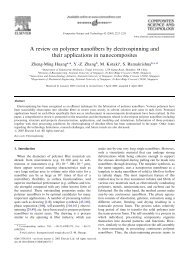
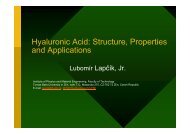

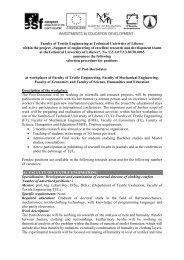
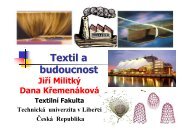
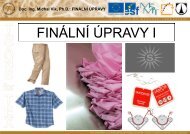

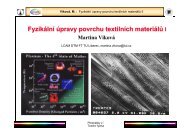
![5 Osvětlení [3 MB]](https://img.yumpu.com/50358472/1/190x134/5-osvetleni-3-mb.jpg?quality=85)
